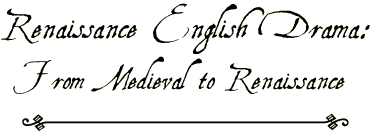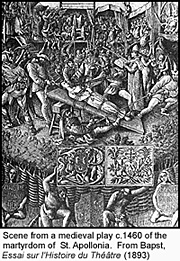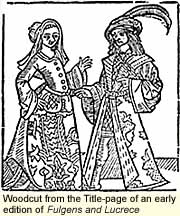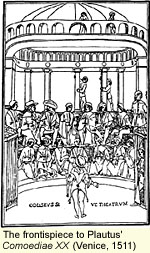|
|
|
|

By Anniina Jokinen, Luminarium.
 English Renaissance drama grew out of the established Medieval tradition of the mystery and morality plays (see Medieval English Drama). These public spectacles focused on religious subjects and were generally enacted by either choristers and monks, or a town's tradesmen (as later seen lovingly memorialized by Shakespeare's 'mechanicals' in A Midsummer Night's Dream). English Renaissance drama grew out of the established Medieval tradition of the mystery and morality plays (see Medieval English Drama). These public spectacles focused on religious subjects and were generally enacted by either choristers and monks, or a town's tradesmen (as later seen lovingly memorialized by Shakespeare's 'mechanicals' in A Midsummer Night's Dream).
At the end of the fifteenth century, a new type of play appeared. These short plays and revels were
performed at noble households and at court, especially at holiday times. These
short entertainments, called "Interludes", started the move away from the
didactic nature of the earlier plays toward purely secular plays, and often
added more comedy than was present in the medieval predecessors. Since most of
these holiday revels were not documented and play texts have disappeared and
been destroyed, the actual dating of the transition is difficult. The first
extant purely secular play, Henry Medwall's Fulgens and Lucres, was performed
at the household of Cardinal Morton, where the young Thomas More was serving as a page. Early Tudor interludes soon grew more elaborate, incorporating music and
dance, and some, especially those by John Heywood, were heavily influenced by French farce.
 Not only were plays shifting emphasis from teaching to entertaining, they were also slowly changing focus from the religious towards the political. John Skelton's Magnyfycence (1515), for example, while on the face of it resembling the medieval allegory
plays with its characters of Virtues and Vices, was a political satire against
Cardinal Wolsey. Magnyfycence was so incendiary that Skelton had to
move into the sanctuary of Westminster to escape the wrath of Wolsey.
Not only were plays shifting emphasis from teaching to entertaining, they were also slowly changing focus from the religious towards the political. John Skelton's Magnyfycence (1515), for example, while on the face of it resembling the medieval allegory
plays with its characters of Virtues and Vices, was a political satire against
Cardinal Wolsey. Magnyfycence was so incendiary that Skelton had to
move into the sanctuary of Westminster to escape the wrath of Wolsey.
The first history plays were written in the 1530's, the most notable of which was John Bale's King Johan. While it considered matters of morality and religion, these were handled in the
light of the Reformation. These plays set the precedent of presenting history in
the dramatic medium and laid the foundation for what would later be elevated by
Marlowe and Shakespeare into the English History Play, or Chronicle Play, in the latter part of the century.
 Not only was the Reformation taking hold in England, but the winds of Classical Humanism were sweeping in from the Continent. Interest grew in the classics and the plays of classical
antiquity, especially in the universities. Latin texts were being "Englysshed"
and latin poetry and plays began to be adapted into English plays. In 1553, a
schoolmaster named Nicholas Udall wrote an English comedy titled "Ralph Roister
Doister" based on the traditional Latin comedies of Plautus and Terence. The
play was the first to introduce the Latin character type miles gloriosus
("braggart soldier") into English plays, honed to perfection later by
Shakespeare in the character of Falstaff. Around the same time at Cambridge, the comedy "Gammer Gurton's Needle", possibly by William Stevens of Christ's College, was amusing the students. It paid closer attention to the structure of the Latin plays and was the first to adopt the five-act division.
Not only was the Reformation taking hold in England, but the winds of Classical Humanism were sweeping in from the Continent. Interest grew in the classics and the plays of classical
antiquity, especially in the universities. Latin texts were being "Englysshed"
and latin poetry and plays began to be adapted into English plays. In 1553, a
schoolmaster named Nicholas Udall wrote an English comedy titled "Ralph Roister
Doister" based on the traditional Latin comedies of Plautus and Terence. The
play was the first to introduce the Latin character type miles gloriosus
("braggart soldier") into English plays, honed to perfection later by
Shakespeare in the character of Falstaff. Around the same time at Cambridge, the comedy "Gammer Gurton's Needle", possibly by William Stevens of Christ's College, was amusing the students. It paid closer attention to the structure of the Latin plays and was the first to adopt the five-act division.
Writers were also developing English tragedies for the first time, influenced by Greek and Latin writers. Among the first forays into English tragedy were Richard Edwards' Damon and Pythias (1564) and John Pickering's New Interlude of Vice Containing the History of Horestes (1567). The most influential writer of classical tragedies, however, was the Roman playwright Seneca, whose works were
translated into English by Jasper Heywood, son of playwright John Heywood, in
1589. Seneca's plays incorporated rhetorical speeches, blood and violence, and
often ghosts; components which were to figure prominently in both Elizabethan
and Jacobean drama.
 The first prominent English tragedy in the Senecan mould was Gorboduc (1561), written by two
lawyers, Thomas Sackville and Thomas Norton, at the Inns of Court (schools of law). The play is also important as the first English play in blank verse. Blank verse,
non-rhyming lines in iambic pentameter, was introduced into English literature by
sonneteers Wyatt and Surrey in the 1530's. Its use in a work of dramatic literature paved the way for "Marlowe's mighty line" and the exquisite poetry
of Shakespeare's dramatic verse. With a new ruler on the throne, Queen Elizabeth I, who enjoyed and encouraged the theatrical arts, the stage was set for the body of dramatic literature we today call Elizabethan Drama. The first prominent English tragedy in the Senecan mould was Gorboduc (1561), written by two
lawyers, Thomas Sackville and Thomas Norton, at the Inns of Court (schools of law). The play is also important as the first English play in blank verse. Blank verse,
non-rhyming lines in iambic pentameter, was introduced into English literature by
sonneteers Wyatt and Surrey in the 1530's. Its use in a work of dramatic literature paved the way for "Marlowe's mighty line" and the exquisite poetry
of Shakespeare's dramatic verse. With a new ruler on the throne, Queen Elizabeth I, who enjoyed and encouraged the theatrical arts, the stage was set for the body of dramatic literature we today call Elizabethan Drama.

To cite this article:
Jokinen, Anniina. "Renaissance English Drama:
From Medieval to Renaissance." Luminarium.
10 Aug 2010. [Date you accessed this article].
<http://www.luminarium.org/renlit/dramamedren.htm>

Continue to:
From Medieval to Renaissance
The Sociopolitical Climate
in Elizabethan England
Elizabethan World View
Elizabethan Playhouses
Elizabethan Staging
Conventions
Timeline of Elizabethan Playhouses and Acting Companies
 | to Renaissance Drama
|
 | to Renaissance Literature
|
Site copyright ©1996-2010 Anniina Jokinen. All rights reserved.
This page created by Anniina Jokinen on August 2, 2006. Last updated August 10, 2010.
|
|
|